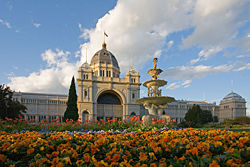Royal Exhibition Building
| Royal Exhibition Building and Carlton Gardens* | |
|---|---|
| UNESCO World Heritage Site | |
 |
|
| State Party | |
| Type | Cultural |
| Criteria | ii |
| Reference | 1131 |
| Region** | Asia-Pacific |
| Inscription history | |
| Inscription | 2004 (28th Session) |
| * Name as inscribed on World Heritage List. ** Region as classified by UNESCO. |
|
The Royal Exhibition Building is a World Heritage listed building located in Melbourne, Australia, completed in 1880. It is located in the Carlton Gardens, at the north-eastern edge of the central business district. It was built to host the Melbourne International Exhibition in 1880 and later hosted the opening of the first Parliament of Australia in 1901. Throughout the 20th century smaller sections and wings of the building were subject to demolition and fire, however the main building survived.
It received restoration throughout the 1990's and in 2004 became the first building in Australia to be awarded UNESCO World Heritage status, being one of the last remaining major nineteenth century exhibition buildings in the world. It sits adjacent to the Melbourne Museum and is the largest item in Museum Victoria's collection. Today, the building hosts various small exhibitions and other events and is closely tied with events at the Melbourne Museum.
Contents |
History



The Royal Exhibition Building was designed by the architect Joseph Reed, who also designed the Melbourne Town Hall and the State Library of Victoria. It was completed in 1880, ready for the Melbourne International Exhibition. The building consisted of a Great Hall of over 12,000 square metres and many temporary annexes. The landmark dome is believed to be inspired by the Florence Cathedral.
1880-1901
In the 1880's the building hosted two major International Exhibitions; The Melbourne International Exhibition in 1880 and the Melbourne Centenial Exhibition in 1888 to celebrate a century of European settlement in Australia. The most significant event to occur in the Exhibition Building was the opening of the first Parliament of Australia on 9 May 1901, following the inauguration of the Commonwealth of Australia on 1 January. After the official opening, the federal government moved to the Victorian State Parliament House, while the Victorian government moved to the Exhibition Building for the next 26 years.
1901-1970's
The period after this time saw the building used for many purposes. It was a main venue for the 1956 Summer Olympics, hosting the basketball, weightlifting and wresting competitions.[1] As it decayed, it became known derogatively by locals as the The White Elephant in the 1940s[2] and by the 1950s, ironically, like many buildings in Melbourne of that time it was earmarked for replacement by office blocks.[3] The wing of the building which once housed Melbourne's aquarium burnt down in 1953. The grand ballroom was demolished in 1979, leaving the main structure in place along with annexes constructed in the 1960s and 1970s. [4] Following the demolition of the grand ballroom there was a public outcry which prevented the main building also from being demolished.
1980's-present
In 1984 when Queen Elizabeth II visited Victoria she granted the prefix title 'Royal' to the Exhibition Building. This sparked a restoration of the interiors of the building in late 1985,[5] and the construction of a mirror glass annexe (which was later demolished). In 1996 the then Premier of Victoria, Jeff Kennett, proposed the location and construction of Melbourne's State Museum on the adjacent site. Temporary annexes built in the 1960s were removed and in 1997 and 1998, the exterior of the building was progressively restored.
The location of the State Museum close to the Exhibition Building site was strongly opposed by the Victorian State Labor Party, the Melbourne City Council and the local community. It was as a result of the community campaign opposing the museum development that John Brumby, then State opposition leader, with the support of the Melbourne City Council, proposed the nomination of the Royal Exhibition Buildings for world heritage listing. The world heritage nomination did not progress until the election of the Victorian State Labor Party as the new government in 1999.
In 2004, the Royal Exhibition Building along with the surrounding Carlton Gardens was granted listing as a World Heritage Site, the first building in Australia to be granted this status. The heritage listing states that The Royal Exhibition Building is the only major extant nineteenth century exhibition building in Australia. It is one of the few major nineteenth century exhibition buildings to survive worldwide.
Current Use

This building is still in use as an exhibition centre for various events on a regular basis such as the Melbourne International Flower and Garden Show. It is mostly used for private tours attached to the nearby Melbourne Museum.
However, it is no longer Melbourne's largest or busiest exhibition centre. The modern equivalent of the Exhibition Building is the Melbourne Exhibition and Convention Centre, located in Southbank to the south of the central city area. The Royal Exhibition Building is also used as an exam hall for the University of Melbourne, Royal Melbourne Institute of Technology, Melbourne High School and Mac.Robertson Girls' High School
See also
- Garden Palace - Sydney's exhibition building.
- Melbourne Museum
- Carlton Gardens
References
- ↑ The Royal Exhibition Building in Melbourne
- ↑ "The Royal Exhibition Building" museumvictoria.com.au. URL accessed on 6 November 2007.
- ↑ "Who will save Melbourne from the wrecker's ball?" theage.com.au 15 March 2004. URL accessed on 5 September 2006.
- ↑ museumvictoria.com.au/pages/845/REBNom_3.pdf
- ↑ "Global status for our greatest building" theage.com.au 21 October 2002. URL accessed on 5 September 2006.
External links
- World heritage listing for the Royal Exhibition Building
- http://museumvictoria.com.au/reb/
- Royal Exhibition Building is at
|
|||||||
|
||||||||||||||||||||||||||
| Preceded by Messuhalli II Helsinki |
Olympic Basketball tournament Final Venue 1956 |
Succeeded by Palace of Sports Rome |